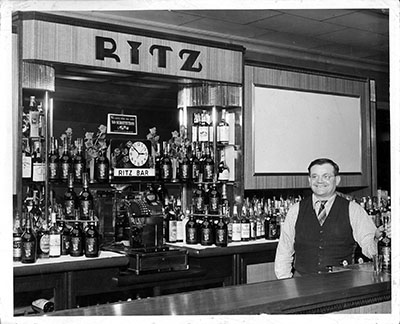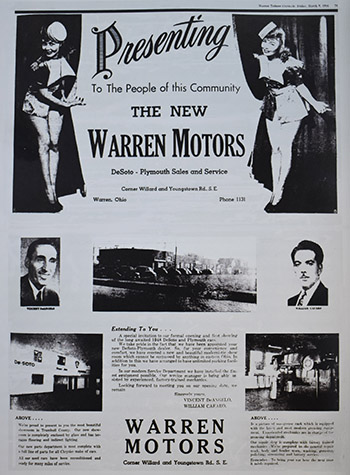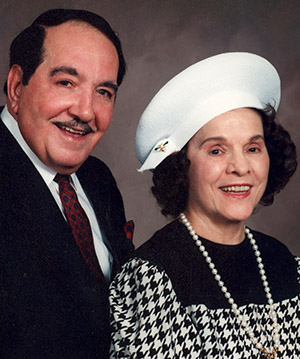(First in a two-part series.)
NILES – One word comes to Anthony Cafaro Sr. when he describes his father, the late William Cafaro, patriarch of one of the Mahoning Valley’s most prominent families and founder of The Cafaro Co.
“Visionary,” says Cafaro, now the retired president of the company. “His timing of getting into various types of industries was impeccable. He knew the best business to get into at any particular time.”
The Cafaro Co. – today headquartered in Niles and among the most successful commercial retail developers in the country – was established 75 years ago with the construction of its first project, an 11,000-square-foot freestanding Kroger supermarket in Barberton, near Akron.
Cafaro’s first commercial development was telling: It reflected fast-moving demographic trends set in motion by returning GIs and their young families in the years following World War II.
“At that time, the federal government promoted suburban growth and at the same time, in the 1950s, they started to build the interstate highway system,” Cafaro notes. These systems bypassed inner cities. The interchanges on the outskirts provided a perfect opportunity for new retail centers as the suburban population increased. Such trends were not lost on William Cafaro.
“He was able to interpret those [trends] to what they would do to the retail shopping industry,” Cafaro says. “He jumped on board.”
Foundation and Innovation
That William Cafaro would seize such an opportunity was hardly surprising, his son reflects. Born to Italian immigrants on Youngstown’s east side, Cafaro proved himself as industrious at an early age. During the Great Depression, the future mall developer landed a position at Truscon Steel – then on Albert Street where the Ross Industrial Park stands today. By 1932, the 19 year-old Cafaro held a management position at the company’s quality control department.

It was through this position that William Cafaro laid the foundation for his first business venture. Political winds had shifted in 1932 with the election of President Franklin D. Roosevelt, who had promised to end Prohibition. Calculating the next trend, Cafaro’s father, Antonio, made a building he owned at the corner of Shehy and Wilson avenues available to William for the purpose of opening a tavern.
“He had the vision of a place called the Ritz Bar but didn’t have any money to work with,” since the building required extensive remodeling, Anthony Cafaro recalls.
To raise money, Cafaro appealed to workers at Truscon, selling food and drink tickets for 50 cents apiece. “Over the course of a year and a half, he raised $1,500 and used that money to renovate the Ritz Bar,” he says. “He knew in advance that the bar business would be the right place at that time.”
Tom Welsh, author of “The Life and Legacy of William Cafaro,” a biography privately published by Anthony Cafaro Sr. in 2021, says that William Cafaro had a knack for making something out of nothing.
“As a foreman at Truscon, he sold tickets for the Ritz Bar that didn’t exist,” Welsh says. “That gave him the funding to get the liquor license, refurbish the building and create something new that was the landmark of the East Side for decades.”
The Ritz opened in 1934 under the management of William and his brother John. It attracted some of the best-known names in entertainment over the next several decades. During the 1940s, the venue booked the Tommy Dorsey Orchestra and its skinny vocalist, Frank Sinatra, Glenn Miller and his orchestra, as well as many regional acts.
“It was a center of jazz music for years, even after the Cafaros sold it,” Welsh says. “Any major acts that came through Youngstown found themselves at places like the Ritz.” Sinatra, he says, was especially fond of the food – prepared by William Cafaro’s mother, Flora.
Sinatra later reflected on those years with great affection, Welsh says. On one occasion during the mid-1970s, William Cafaro was asked by International Council of Shopping Centers President Al Sussman to convince Sinatra to appear at the ISCS’s luncheon the following afternoon in Las Vegas, where the singer was performing.
Cafaro then directed his younger son, J.J., to present a box of cigars to Billy Weinberger, the manager of Caesar’s Palace, and ask whether he could get Sinatra to speak at the luncheon. As J.J. Cafaro relates the story in “The Life and Legacy,” Weinberger couldn’t commit but suggested the two drive a golf cart across the street to the Dunes Hotel & Casino, where Sinatra was on its putting green.

After Weinberger introduced the young Cafaro to the entertainer, Sinatra replied, “Bill Cafaro’s son? I’ll do it in a heartbeat. You don’t know how many times I would not have eaten, when I was on the road in the early days, if it weren’t for your grandmother cooking for me in the kitchen of the Ritz.”
Unfortunately, a scheduling conflict precluded Sinatra’s appearance at the luncheon. Instead, the singer arranged for Pat Henry, an Italian American comedian to stand in for the event.
While still busy with the Ritz, Cafaro jumped at the opportunity to launch his next venture, this time reading correctly the pent-up demand for automobiles that were impossible to purchase during the war years.
“Nobody had bought a new car in five years,” Anthony Cafaro says. “What did he do? He opened Warren Motors – a Plymouth and DeSoto dealership. He couldn’t get enough cars they were selling so fast.” William Cafaro opened the dealership in 1946 and sold it in 1952.
Once again, William Cafaro’s business acumen proved as astute as ever. “He sold in ’52,” Cafaro says. “He had an inkling, had the understanding. In ’53 they eliminated DeSoto. So he made the move at the right time.”
Making the Move to Real Estate
By then, Cafaro’s interests had turned strictly to commercial retail development, beginning with the stand-alone Kroger’s in 1949, and later that year, the Sharon Towne Strip Plaza, in Sharon, Pa. With these two developments, William Cafaro & Associates, as the company was then called, laid the foundations of a retail plaza and shopping mall empire that would stretch across the country.

None of it was easy, Anthony Cafaro Sr., says. During the 1950s, the company developed strip plazas such as Glenwood Avenue Stores, McKinley Heights Shopping Plaza, Elm Road Plaza, and McGuffey Plaza. The Mahoning Plaza, which still stands, was a project developed in partnership between Cafaro and Edward J. DeBartolo Jr., also a local rising star among the country’s commercial retail developers. Other plazas Cafaro developed during that decade were in Canton, Ashtabula, Erie, Pa.; and Muncie, Ind.. College Plaza, constructed in 1958 in Alliance, is still owned by the Cafaro Co.
“People didn’t believe that strip centers were going to make it,” Anthony Cafaro Sr. says. While these plazas would be anchored with names such as Kroger, or F.W. Woolworth, it was harder to recruit smaller retailers and merchants as tenants because they were reluctant to leave the central business districts.
To prove otherwise, William Cafaro established a line of clothing and accessory shops, Tony Jay’s Menswear, Vivian’s Fashions for women, and Field’s Shoes. “These weren’t big chains,” Cafaro recalls. “What he would do is he would show that they were profitable then sell them to local merchants.”
Many older, family-owned businesses were hemmed in the downtowns with limited parking, Cafaro says. “We had an abundance of free parking,” he adds, noting that tenants within these plazas created a synergy that boosted business for all of the retailers. “The whole concept of shopping centers is to feed off one another,” he says.
As the suburbs and interstate system grew – and motor vehicles replaced public transit as the preferred means of transportation – the company pivoted toward a new idea just taking shape in limited markets across the country: the first shopping malls.
“He was able to – many, many times throughout his career – change with the circumstances,” Cafaro says. “He was a traditionalist in his values but a visionary when it came to making the proper moves based upon the business climate prevailing at that time.”
What many don’t understand, Cafaro says, was that during the early days, the business wasn’t exactly flush with cash. Despite a public persona that in his later years reflected great success and wealth, William Cafaro was downright frugal relative to his personal expenses. “He wasn’t always a person of wealth and success,” the son says.
By the mid-1960s, the company turned its sights on developing enclosed shopping malls. As early as 1964, William Cafaro & Associates put in motion plans to construct a large mall on 62 acres in Boardman on the east side of Market Street.
That land would require a zoning change, however, a change initially opposed by the Edward J. DeBartolo Corp., which owned the Greater Boardman Shopping Plaza less than a mile away along U.S. 224. DeBartolo also owned 16 acres at the corner of Market and U.S. 224, land contiguous to Cafaro property. The two developers maintained a friendship and worked out a deal that would culminate in the construction of Southern Park Mall.
Meanwhile, Cafaro began scouting a site for a second mall, this one in Trumbull County. In June 1965, Howland Township trustees approved a zoning ordinance that cleared the path for construction of an $8.5 million enclosed shopping mall at the site of the Eastwood Golf Course along U.S. 422.
Cafaro bought the 125-acre site in January 1966. Work on what would become Eastwood Mall started by 1967, but not without its own set of challenges.
“We almost went broke on the construction of Eastwood Mall,” Anthony Cafaro says. “He put second and third mortgages on every property he owned to pay the bills.”
RELATED STORY
Cafaro Co. at 75: A Vision Realized
Pictured at top: Anthony Cafaro Sr. sits at his desk in the company’s headquarters at the Eastwood Complex.
